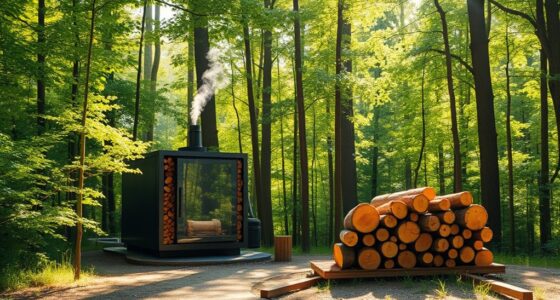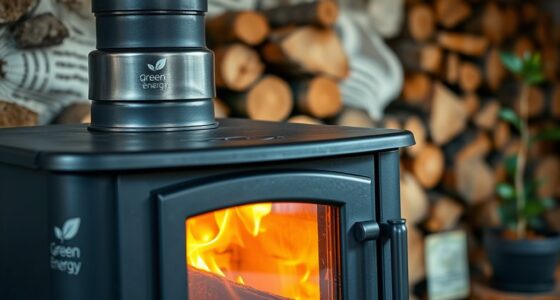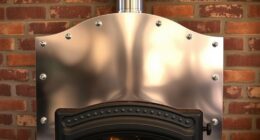When comparing lifecycle carbon, wood can be more environmentally friendly if sustainably harvested and burned efficiently, as trees absorb CO₂ during growth. Burning wood releases stored carbon, but ongoing forest management helps keep net emissions low. Propane, on the other hand, is a fossil fuel with higher overall emissions since it doesn’t sequester carbon naturally. To fully understand their environmental impacts, consider how ideal practices influence their carbon footprints—more details await those who explore further.
Key Takeaways
- Wood can be nearly carbon-neutral if sustainably harvested, as it sequesters CO₂ during growth, offsetting emissions when burned.
- Propane’s lifecycle involves significant emissions from extraction, refining, and combustion, resulting in higher overall carbon footprint.
- Well-maintained wood stoves maximize efficiency and reduce emissions, while propane offers high efficiency with cleaner combustion.
- Sustainable forest management ensures wood’s low net carbon emissions, but improper practices can increase its environmental impact.
- Overall, wood’s lifecycle carbon impact depends on harvesting practices, whereas propane’s is influenced by fossil fuel processing and use.

Have you ever wondered which fuel has a lower overall carbon footprint—wood or propane? When evaluating their environmental impacts, it’s essential to consider the entire lifecycle, from production to combustion. Wood, as a renewable resource, has an interesting relationship with carbon sequestration. Trees absorb carbon dioxide from the atmosphere as they grow, effectively acting as natural carbon sinks. When you burn wood, you’re releasing some of that stored carbon back into the atmosphere, but if forests are sustainably managed, new trees are planted to replace those used, maintaining a balance over time. This cycle helps keep the net carbon emissions relatively low, especially when harvesting is done responsibly. Proper forest management is crucial to ensuring the sustainability of wood as a low-carbon fuel source. Propane, on the other hand, is a fossil fuel derived from natural gas processing and oil refining. Its extraction and refining involve significant energy consumption and greenhouse gas emissions, which contribute to its overall carbon footprint. Unlike wood, propane doesn’t have a natural process of carbon sequestration, so each use adds to atmospheric carbon levels without the compensating benefit of ongoing absorption. Additionally, vetted information emphasizes that the environmental benefits of wood depend heavily on sustainable forest management practices. Fuel efficiency plays a vital role in overall carbon emissions. Wood can be quite efficient if you have a modern, well-maintained stove or furnace that maximizes heat output while minimizing waste. However, traditional or poorly maintained appliances might burn wood inefficiently, releasing more particulate matter and carbon dioxide per unit of heat generated. Propane typically boasts high fuel efficiency because it burns cleaner and more completely than many other traditional fuels, producing fewer emissions per unit of energy. This higher efficiency means less fuel is needed to produce the same amount of heat, which can reduce the total lifecycle emissions associated with its use. When evaluating the entire lifecycle, wood has the advantage of being renewable and potentially carbon-neutral when harvested sustainably. Its ability to sequester carbon during growth helps offset emissions released upon burning. Both fuels can be used efficiently, but the environmental impact hinges on factors like forest management practices for wood and appliance efficiency for both fuels. Proper appliance maintenance can significantly improve combustion efficiency and reduce emissions. Furthermore, advancements in technological innovations are contributing to cleaner burning methods for both fuels, improving their environmental profiles. Ultimately, if your goal is to minimize lifecycle carbon emissions, wood from sustainably managed forests combined with high-efficiency appliances can be a better choice. But for immediate, high-efficiency heating, propane offers a cleaner burn, though it comes with a more significant footprint in terms of fossil fuel consumption.
Frequently Asked Questions
How Does Transportation Impact the Lifecycle Carbon of Wood and Propane?
Transportation impacts the lifecycle carbon of wood and propane through transportation emissions, which notably contribute to their overall carbon footprint. You should consider supply chain logistics since longer distances and less efficient routes increase emissions. For wood, transporting bulky logs or processed timber adds to its footprint, while propane’s liquid transport also generates emissions. Efficient logistics and local sourcing can reduce these impacts, making both options more environmentally friendly.
What Are the Environmental Impacts of Harvesting Wood Versus Extracting Propane?
Like stepping into a time machine, harvesting wood impacts the environment through reforestation practices and careful management, reducing deforestation. Extraction methods for propane, however, involve drilling and fracking, which can cause habitat disruption and groundwater contamination. You should consider that sustainable harvesting minimizes ecological damage, whereas fossil fuel extraction often leads to long-term environmental issues. By choosing wisely, you help balance energy needs with planetary health.
How Do Storage and Handling Affect the Carbon Footprint of Each Fuel?
Your storage practices and handling safety substantially impact each fuel’s carbon footprint. Properly storing wood minimizes decay and methane emissions, reducing overall emissions. For propane, secure handling prevents leaks that release greenhouse gases. Efficient storage and careful handling decrease the need for additional energy, lowering environmental impacts. By maintaining safe, ideal storage, you help guarantee that the carbon footprint of both wood and propane stays as low as possible.
Are There Regional Differences in Lifecycle Emissions for Wood and Propane?
Regional variability considerably influences the lifecycle emissions of wood and propane. You’ll find that emission factors differ based on local forestry practices, transportation distances, and energy sources. For example, wood emissions depend on regional forest management, while propane’s impact varies with regional production methods. These differences mean your carbon footprint can shift depending on where you are, highlighting the importance of understanding local practices when evaluating each fuel’s environmental impact.
How Do Future Technological Advancements Influence Lifecycle Carbon Assessments?
Future technological innovations can substantially lower lifecycle carbon emissions by improving efficiency and reducing emissions during extraction, processing, and use. You’ll benefit as these advancements enable cleaner production methods, better fuel utilization, and smarter energy management. As a result, emission reductions become more achievable, making wood and propane more sustainable options. Staying informed about these innovations helps you make environmentally conscious decisions, supporting a shift toward lower-carbon energy sources.
Conclusion
When comparing the lifecycle carbon of wood and propane, you’ll find that wood generally has a lower overall footprint, especially when sustainably sourced. Notably, burning wood releases about 50% less carbon than propane over its lifecycle. This means choosing wood can considerably reduce your carbon impact, making it a better option for eco-conscious decisions. By understanding these differences, you can make smarter choices that help protect the environment for future generations.











